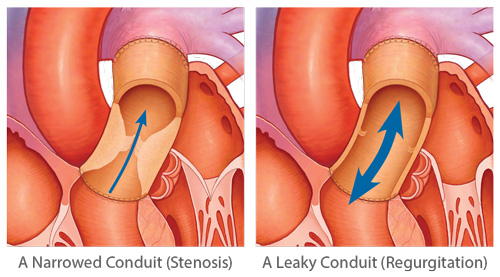Valve Conditions
Pulmonary Valve Conditions
If your doctor has recommended that you read the Melody TPV patient education booklet, you may have one of the following congenital heart conditions that most commonly affect the pulmonary valve:
Pulmonary Atresia A condition where the pulmonary valve is abnormal and does not open like it should. This means that blood cannot go to the lungs to pick up oxygen.
Tetralogy of Fallot A condition which refers to four heart defects that usually occur together; a hole between the right and left pumping chambers of the heart (ventricles), a narrowed path between the heart and the lungs, an artery (aorta) that is connected to the heart closer to the right side of the heart than normal, and a thicker than normal pumping chamber (ventricle) on the right side of the heart.
Double Outlet Right Ventricle A condition in which both main arteries, one that carries blood to the lungs (pulmonary artery) and one that carries blood to the rest of the body (aorta), are connected to the right lower chamber of the heart (ventricle). Usually, the aorta is connected to the left lower chamber of the heart.
Children and adults with these conditions have narrowed pulmonary valves and need surgery for placement of a right ventricular outflow tract (RVOT) or pulmonary conduit. A pulmonary conduit is a tube that connects the heart to the lungs.

Pulmonary Valve Conduit Failure
Over time, mineral deposits may build up on the conduit (calcification), and it may become narrowed and/or leaky. This may happen as you outgrow the conduit or as the conduit wears out from the pressures of pumping blood or from calcium build up.
A Narrowed Conduit (Stenosis) The conduit opening is narrowed, which limits blood flow from the heart to the lungs and forces the heart to work harder than normal. Stenosis may be caused by a build up of minerals on the conduit walls (calcification). Stenosis can make the heart muscle thick and prevent it from working well. It can also limit the amount of blood pumped to the lungs.
A Leaky Conduit (Regurgitation) The conduit does not have a working valve which causes blood to leak backward into the right lower chamber of the heart (ventricle). This causes the heart to pump harder than it should to bring blood to the lungs and the rest of your body.
Symptoms of Pulmonary Valve Conduit Failure
- Becoming tired or short of breath with activity
- Feeling tired, dizzy or too weak to do your normal activities
- Irregular heart beats or the feeling that your heart is racing or pounding in your chest
- Fainting or near fainting
Symptoms can range from mild to severe. If you are experiencing any of these symptoms, talk with your doctor. Regular check ups and testing can help determine how your pulmonary valve conduit is working.




